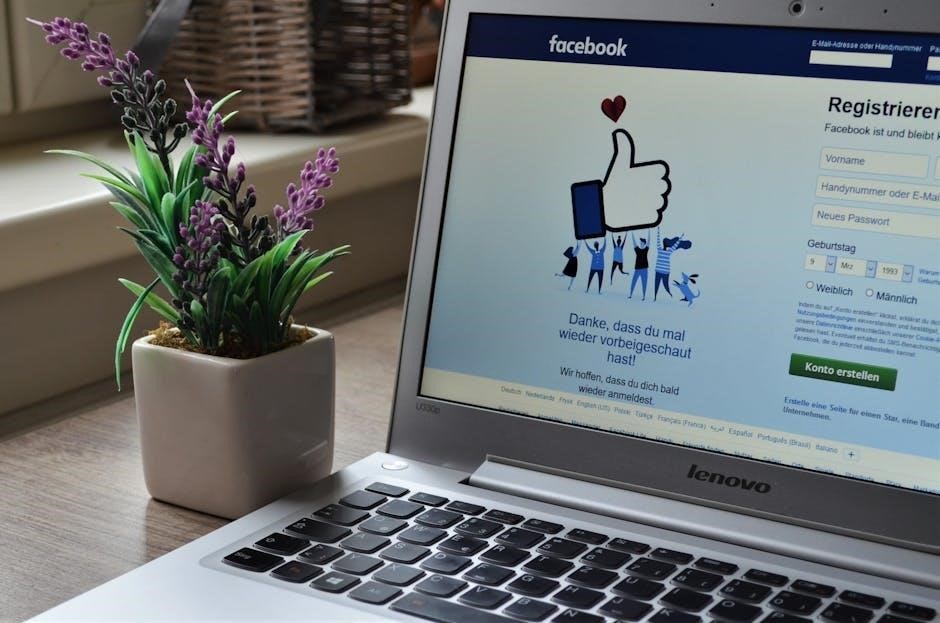Brand Name and Description
Your brand name is the cornerstone of your identity, reflecting your values and mission. The one-liner description concisely captures your brand’s essence, ensuring clarity and consistency across all platforms.
1.1 Brand Name
Your brand name is the foundation of your identity, reflecting your values and mission. It should be memorable, unique, and resonate with your target audience. Ensure the name aligns with your brand’s purpose and is easy to pronounce and spell. This name will serve as the cornerstone for all your branding efforts, making it essential to choose wisely. It is the first element that defines your brand’s personality and sets the tone for your one-page brand guide.
1.2 One-Liner Description
A one-liner description is a concise and impactful sentence that captures the essence of your brand. It should clearly communicate your brand’s purpose, values, and unique value proposition. This statement serves as a quick reference for stakeholders and audiences, ensuring consistency in how your brand is perceived. Craft it to be memorable, aligned with your mission, and reflective of your brand’s personality. It forms the core of your brand’s messaging and identity in the one-page guide.

Logo Variations
This section includes the primary logo, alternate versions, and brand marks, ensuring versatility for different applications while maintaining brand consistency and visual identity.
2.1 Primary Logo
The primary logo is your brand’s most prominent visual element, designed for versatility across digital and print platforms. It encapsulates your brand’s identity and is essential for recognition. Use it consistently to maintain a cohesive image. Ensure scalability and legibility in various sizes and formats. Include variations if needed, but always prioritize clarity and brand integrity for a professional appearance.
2.2 Alternate Logo
The alternate logo offers flexibility for specific use cases, such as social media profiles or promotional materials. It maintains brand consistency while adapting to different formats. Use this version when the primary logo’s size or orientation isn’t suitable. Ensure the alternate logo aligns with the primary in style and messaging to preserve brand recognition and integrity across all applications.
2.3 Brand Mark
The brand mark is a standalone icon or symbol representing the brand, often used without the logotype. It provides versatility for applications like app icons, social media avatars, or merchandise. Ensure the brand mark aligns with the primary logo’s style for consistency. Use it in scenarios requiring a simplified or more compact representation of the brand. Always maintain minimum size requirements to preserve detail and ensure proper spacing to avoid visual clutter.
Color Palette
The color palette defines your brand’s core colors, including HEX codes for digital use. It ensures consistency across all platforms, reinforcing your brand’s visual identity and professional appearance.
3.1 Core Colors with Hex Codes
Your core colors are the primary shades representing your brand. Include their HEX codes for precise digital replication. For example, a brand might use #2E7D32 for green and #AFB4DB for a complementary light shade. These codes ensure consistency across websites, social media, and marketing materials, maintaining your brand’s visual coherence and professional look. Always list them clearly for easy reference and accurate application.
3.2 Usage Guidelines for Colors
Use the core colors consistently to maintain brand recognition. Apply the primary color for logos and headers, secondary colors for backgrounds and accents, and accent colors sparingly to draw attention. Ensure a minimum contrast ratio of 4.5:1 for readability. Avoid over-saturating designs with too many colors. Use white or light backgrounds to prevent visual clutter. These guidelines ensure harmony and professionalism across all platforms, reinforcing your brand’s visual identity and cohesive messaging. Always refer to the HEX codes provided for accurate color reproduction.

Typography
Typography reinforces brand identity through consistent font choices. Use designated fonts for headings to grab attention and for body text to ensure readability across all platforms.
4.1 Font for Headings
The font for headings should be bold and eye-catching, such as “Playfair Display” or a similar serif font, to create a strong visual hierarchy. This font is ideal for titles and key messaging, ensuring readability and aesthetic appeal. It should align with the brand’s identity, conveying sophistication and professionalism while maintaining legibility across digital and print platforms.
4.2 Font for Body Text
The font for body text should be clean and highly readable, such as “Helvetica” or “Open Sans,” ensuring clarity in both digital and print formats. This font is used for paragraphs, descriptions, and other written content, maintaining a professional yet approachable tone. It should be consistent across all materials to uphold brand identity, with a recommended size of 14-16px for digital and 10-12pt for print to ensure optimal readability and visual harmony.
4.3 Examples of Usage
Use the heading font for titles, such as “Playfair Display,” to create visual hierarchy and draw attention. The body font, like “Open Sans,” is ideal for paragraphs, ensuring readability. Apply these fonts consistently across websites, social media, and marketing materials. For example, use the heading font for blog titles and the body font for article content. Maintain font sizes between 14-16px for digital text and 10-12pt for print to ensure optimal legibility and brand coherence.
Imagery and Tone of Voice
Use high-quality, authentic imagery that aligns with your brand’s message. Tone of voice should be clear, consistent, and reflective of your brand’s personality, ensuring a cohesive communication style.
5.1 Photography Style
Your brand’s photography should be high-quality, authentic, and consistent. Use natural lighting, clean compositions, and subjects that reflect your brand’s values. Avoid overly staged or cluttered images. Ensure photos are cohesive with your brand’s messaging and tone, creating a visual narrative that resonates with your audience. For example, use minimal props and focus on the subject to maintain simplicity and professionalism. This approach ensures visual harmony across all platforms.
5.2 Tone of Voice Guidelines
Your tone of voice should be clear, approachable, and consistent. Use active voice to convey confidence and readability. Avoid jargon and overly complex language. Ensure your messaging aligns with your brand’s personality, whether it’s professional, friendly, or inspirational. Maintain a conversational tone that resonates with your audience, fostering trust and connection. Consistency in tone ensures your brand’s voice is recognizable across all platforms and communications.

Usage Guidelines
Ensure consistent use of brand elements like logos, colors, and typography. Follow specific dos and don’ts to maintain brand integrity and visual coherence across all platforms.
6.1 Dos for Logo Usage
Always use high-resolution logo files for clarity. Ensure proper spacing around the logo to avoid clutter. Use the logo in approved color variations only. Maintain the logo’s aspect ratio and legibility. Apply the logo consistently across all platforms to uphold brand recognition and professionalism. Refer to the one-page guide for correct logo placement and sizing. This helps preserve the brand’s visual identity and ensures a cohesive look in all communications and materials.
6.2 Don’ts for Logo Usage
Avoid stretching, skewing, or resizing the logo disproportionately. Never use low-resolution or pixelated versions. Do not add text, graphics, or effects over the logo. Avoid altering the logo’s colors or switching the approved color palette. Refrain from using outdated versions of the logo. Do not place the logo on busy or cluttered backgrounds that compromise its visibility. Ensure the logo is not cropped or partially obscured in any medium. Adhere strictly to the guidelines to maintain brand integrity and professionalism.
Additional Brand Assets
Additional brand assets include patterns, textures, and icons that complement the logo and color palette. These elements enhance visual identity while maintaining consistency across all platforms.
7.1 Patterns
Patterns are reusable design elements that add texture and depth to your brand’s visual identity. They can be geometric shapes, organic motifs, or custom designs. Use patterns sparingly to enhance layouts without overpowering the core brand elements. For example, a subtle geometric pattern can add interest to backgrounds or social media posts. Ensure patterns align with your brand’s aesthetic and are used consistently across all platforms for a cohesive look.
7.2 Icons
Icons are visual symbols that reinforce your brand’s identity and communicate specific messages. Use them to complement text or standalone in digital interfaces, apps, or marketing materials. Ensure icons are simple, scalable, and consistent in style. They should align with your brand’s aesthetic and core values. For example, use a custom icon set that reflects your industry or mission, ensuring they are versatile across different mediums and maintain brand cohesion.

Examples
This section provides visual examples of correct and incorrect brand element usage, ensuring clarity and consistency in application. Refer to specific sections for detailed guidelines.
8.1 Correct Usage Examples
Examples of correct logo placement, color application, and typography ensure brand consistency. Proper logo scaling, approved color codes, and consistent font styles are demonstrated. Imagery aligns with the brand’s visual identity, maintaining professionalism and coherence. These examples serve as a reference for all marketing materials, ensuring the brand is represented uniformly across platforms. Correct usage examples help maintain the brand’s integrity and professional image, guiding all creative decisions.
8.2 Incorrect Usage Examples
Incorrect usage includes stretching or altering the logo proportions, using unapproved color variations, and inconsistent typography. Overly complex imagery or unrelated visuals can dilute the brand’s message. Misaligned spacing or poor contrast in text can reduce readability; These examples highlight common pitfalls to avoid, ensuring the brand’s visual identity remains strong and cohesive. Incorrect usage can weaken brand recognition and professionalism, making it essential to adhere to established guidelines.
Brand Positioning
Brand positioning defines how your brand is perceived in the market, ensuring it resonates with your target audience and stands out through unique value and consistent messaging.
9.1 Market Position
Your brand’s market position is defined by its unique value proposition, target audience, and competitive landscape; It ensures clarity in how your brand stands out and resonates with customers, aligning with their needs and expectations while differentiating from competitors. A strong market position guides consistent messaging and visual identity, reinforcing your brand’s role in the industry. This section highlights your brand’s niche and strategic relevance.
9.2 Core Values
Core values are the fundamental principles that guide your brand’s actions and decisions. They define your brand’s personality and culture, ensuring alignment with your mission and vision. These values resonate with your audience, fostering trust and loyalty. Clearly articulated core values help maintain consistency across all brand communications, reinforcing your identity and purpose. They serve as a compass for internal teams and external partners, ensuring everyone understands what your brand stands for.
Distribution Information
Access the full brand guidelines on our website at [YourWebsite.com/brand-guide]. For more information or inquiries, contact [YourBrand@support.com].
10.1 Accessing Full Guidelines
To access the complete brand guidelines, visit our website. The detailed document includes in-depth rules for logo usage, color palettes, typography, and imagery. This ensures consistency across all platforms and provides a comprehensive reference for maintaining your brand’s identity effectively. The guide is regularly updated, so check back for the latest version.
10.2 Contact for More Info
For questions or additional information, contact our brand team at brand@yourcompany.com. We’re here to help ensure your brand communications are consistent and aligned with our guidelines. Feel free to reach out for clarification on any aspect of the brand guide or to request additional assets. Your inquiries will be addressed promptly to support your creative process and maintain brand integrity across all channels;
